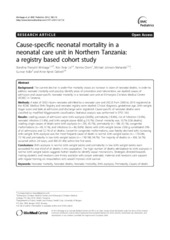Cause-specific neonatal mortality in a neonatal care unit in Northern Tanzania: a registry based cohort study
Mmbaga, Blandina T.; Lie, Rolv Terje; Olomi, Raimos; Mahande, Michael Johnson; Kvåle, Gunnar; Daltveit, Anne Kjersti
Peer reviewed, Journal article
Published version
Permanent lenke
https://hdl.handle.net/1956/6568Utgivelsesdato
2012-08Metadata
Vis full innførselSamlinger
Originalversjon
https://doi.org/10.1186/1471-2431-12-116Sammendrag
Background: The current decline in under-five mortality shows an increase in share of neonatal deaths. In order to address neonatal mortality and possibly identify areas of prevention and intervention, we studied causes of admission and cause-specific neonatal mortality in a neonatal care unit at Kilimanjaro Christian Medical Centre (KCMC) in Tanzania. Methods: A total of 5033 inborn neonates admitted to a neonatal care unit (NCU) from 2000 to 2010 registered at the KCMC Medical Birth Registry and neonatal registry were studied. Clinical diagnosis, gestational age, birth weight, Apgar score and date at admission and discharge were registered. Cause-specific of neonatal deaths were classified by modified Wigglesworth classification. Statistical analysis was performed in SPSS 18.0. Results: Leading causes of admission were birth asphyxia (26.8%), prematurity (18.4%), risk of infection (16.9%), neonatal infection (15.4%), and birth weight above 4000 g (10.7%). Overall mortality was 10.7% (536 deaths). Leading single causes of death were birth asphyxia (n = 245, 45.7%), prematurity (n = 188, 35.1%), congenital malformations (n = 49, 9.1%), and infections (n = 46, 8.6%). Babies with birth weight below 2500 g constituted 29% of all admissions and 52.1% of all deaths. Except for congenital malformations, case fatality declined with increasing birth weight. Birth asphyxia was the most frequent cause of death in normal birth weight babies (n = 179/246, 73.1%) and prematurity in low birth weight babies (n = 178/188, 94.7%). The majority of deaths (n = 304, 56.7%) occurred within 24 hours, and 490 (91.4%) within the first week. Conclusions: Birth asphyxia in normal birth weight babies and prematurity in low birth weight babies each accounted for one third of all deaths in this population. The high number of deaths attributable to birth asphyxia in normal birth weight babies suggests further studies to identify causal mechanisms. Strategies directed towards making obstetric and newborn care timely available with proper antenatal, maternal and newborn care support with regular training on resuscitation skills would improve child survival.
Utgiver
BioMed CentralTidsskrift
BMC PediatricsOpphavsrett
Copyright 2012 Mmbaga et al.; licensee BioMed Central Ltd.Beslektede innførsler
Viser innførsler beslektet ved tittel, forfatter og emneord.
-
Pregnancy and perinatal health outcomes in Northern Tanzania: a registry based study. Neonatal care admissions and recorded causes of neonatal and perinatal deaths
Mmbaga, Blandina T. (Doctoral thesis, 2013-04-26) -
Heart function by M-mode and tissue Doppler in the early neonatal period in neonates with fetal growth restriction
Nestaas, Eirik; Bjarkø, Lisa; Kiserud, Torvid; Haugen, Guttorm Nils; Fugelseth, Drude (Journal article; Peer reviewed, 2023)Background: Fetal growth restricted (FGR) neonates have increased risk of circulatory compromise due to failure of normal transition of circulation after birth. Aim: Echocardiographic assessment of heart function in FGR ... -
Accurate and fast neonatal heart rate assessment with a smartphone‐based application – a manikin study
Höök, Susanna Myrnerts; Pejovic, Nicolas; Marrone, Gaetano; Tylleskär, Thorkild; Alfven, Tobias (Peer reviewed; Journal article, 2018-03-31)Aim: This study determined the accuracy and speed of the NeoTapLifeSupport (NeoTapLS), a free smartphone application that aims to assess a neonate's heart rate. Methods: We asked 30 participants with a variety of backgrounds ...

